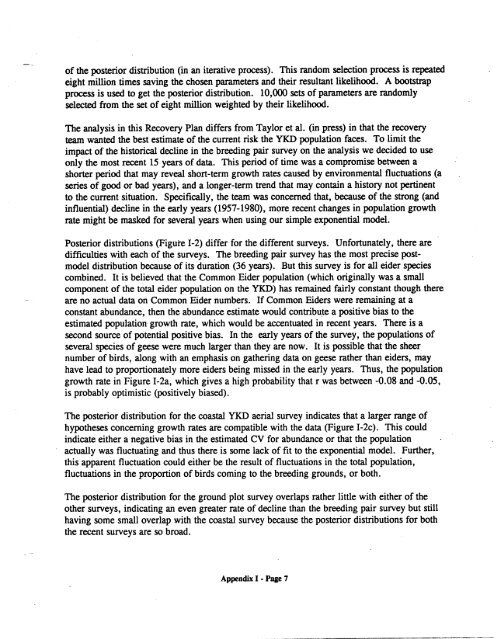A. Status of the Spectacled Eider - U.S. Fish and Wildlife Service
A. Status of the Spectacled Eider - U.S. Fish and Wildlife Service
A. Status of the Spectacled Eider - U.S. Fish and Wildlife Service
Create successful ePaper yourself
Turn your PDF publications into a flip-book with our unique Google optimized e-Paper software.
<strong>of</strong><strong>the</strong> posterior distribution (in an iterative process). This r<strong>and</strong>om selection process is repeated<br />
eight million times saving <strong>the</strong> chosen parameters <strong>and</strong> <strong>the</strong>ir resultant likelihood. A bootstrap<br />
process is used to get <strong>the</strong> posterior distribution. 10,000 sets <strong>of</strong> parameters are r<strong>and</strong>omly<br />
selected from <strong>the</strong> set <strong>of</strong> eight million weighted by <strong>the</strong>ir likelihood.<br />
The analysis in this Recovery Plan differs from Taylor et al. (in press) in that <strong>the</strong> recovery<br />
team wanted <strong>the</strong> best estimate <strong>of</strong> <strong>the</strong> current risk <strong>the</strong> YKD population faces. To limit <strong>the</strong><br />
impact <strong>of</strong> <strong>the</strong> historical decline in <strong>the</strong> breeding pair survey on <strong>the</strong> analysis we decided to use<br />
only <strong>the</strong> most recent 15 years <strong>of</strong> data. This period <strong>of</strong> time was a compromise between a<br />
shorter period that may reveal short-term growth rates caused by environmental fluctuations (a<br />
series <strong>of</strong> good or bad years), <strong>and</strong> a longer-term trend that may contain a history not pertinent<br />
to <strong>the</strong> current situation. Specifically, <strong>the</strong> team was concerned that, because <strong>of</strong> <strong>the</strong> strong (<strong>and</strong><br />
influential) decline in <strong>the</strong> early years (1957-1980), more recent changes in population growth<br />
rate might be masked for several years when using our simple exponential model.<br />
Posterior distributions (Figure 1-2) differ for <strong>the</strong> different surveys. Unfortunately, <strong>the</strong>re are<br />
difficulties with each <strong>of</strong> <strong>the</strong> surveys. The breeding pair survey has <strong>the</strong> most precise postmodel<br />
distribution because <strong>of</strong> its duration (36 years). But this survey is for all eider species<br />
combined. It is believed that <strong>the</strong> Common <strong>Eider</strong> population (which originally was a small<br />
component <strong>of</strong> <strong>the</strong> total eider population on <strong>the</strong> YKD) has remained fairly constant though <strong>the</strong>re<br />
are no actual data on Common <strong>Eider</strong> numbers. If Common <strong>Eider</strong>s were remaining at a<br />
constant abundance, <strong>the</strong>n <strong>the</strong> abundance estimate would contribute a positive bias to <strong>the</strong><br />
estimated population growth rate, which would be accentuated in recent years. There is a<br />
second source <strong>of</strong> potential positive bias. In <strong>the</strong> early years <strong>of</strong> <strong>the</strong> survey, <strong>the</strong> populations <strong>of</strong><br />
several species <strong>of</strong> geese were much larger than <strong>the</strong>y are now. It is possible that <strong>the</strong> sheer<br />
number <strong>of</strong>birds, along with an emphasis on ga<strong>the</strong>ring data on geese ra<strong>the</strong>r than eiders, may<br />
have lead to proportionately more eiders being missed in <strong>the</strong> early years. Thus, <strong>the</strong> population<br />
growth rate in Figure I-2a, which gives a high probability that r was between -0.08 <strong>and</strong> -0.05,<br />
is probably optimistic (positively biased).<br />
The posterior distribution for <strong>the</strong> coastal YKD aerial survey indicates that a larger range <strong>of</strong><br />
hypo<strong>the</strong>ses concerning growth rates are compatible with <strong>the</strong> data (Figure I-2c). This could<br />
indicate ei<strong>the</strong>r a negative bias in <strong>the</strong> estimated CV for abundance or that <strong>the</strong> population<br />
actually was fluctuating <strong>and</strong> thus <strong>the</strong>re is some lack <strong>of</strong> fit to <strong>the</strong> exponential model. Fur<strong>the</strong>r,<br />
this apparent fluctuation could ei<strong>the</strong>r be <strong>the</strong> result <strong>of</strong> fluctuations in <strong>the</strong> total population,<br />
fluctuations in <strong>the</strong> proportion <strong>of</strong> birds coming to <strong>the</strong> breeding grounds, or both.<br />
The posterior distribution for <strong>the</strong> ground plot survey overlaps ra<strong>the</strong>r little with ei<strong>the</strong>r <strong>of</strong> <strong>the</strong><br />
o<strong>the</strong>r surveys, indicating an even greater rate <strong>of</strong> decline than <strong>the</strong> breeding pair survey but still<br />
having some small overlap with <strong>the</strong> coastal survey because <strong>the</strong> posterior distributions for both<br />
<strong>the</strong> recent surveys are so broad.<br />
Appendix I - Page 7

















